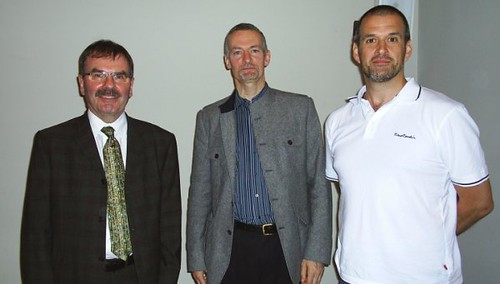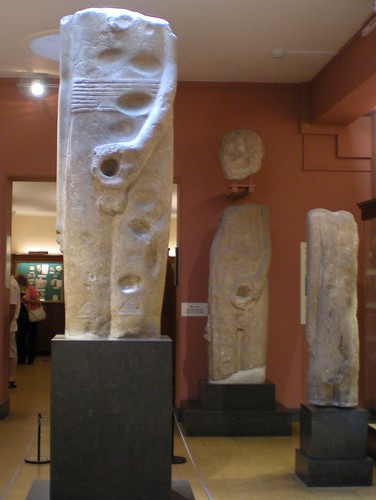 It was a lovely sunny day throughout the UK and everyone at the exquisite Pollok Country Park was making the most of the sunshine. I walked passed the sunbathers to where The Burrell Collection is housed, to attend a Study Day about the work and life of Flinders Petrie, organized by Egyptology Scotland.
It was a lovely sunny day throughout the UK and everyone at the exquisite Pollok Country Park was making the most of the sunshine. I walked passed the sunbathers to where The Burrell Collection is housed, to attend a Study Day about the work and life of Flinders Petrie, organized by Egyptology Scotland.
Magi Sloan, chairperson of Egyptology Scotland, did an excellent job of putting together three specialists on Petrie collections from different parts of the country: Professor Stephen Quirke from the Petrie Museum in London, Simon Eccles, senior curator of Ancient Civilizations at the Burrell Collection and responsible for Glasgow Museums Ancient Civilisations collection as well, and Dr. Bill Manley, former Senior Curator of Egyptian Scripts at the NMS in Edinburgh.
In the Footsteps of Petrie
The first to grab the microphone was Professor Quirke, offering us an introduction to Petries background and elaborating on his technical achievements such as the Great Pyramid survey. The discussion divided Petries career as an archaeologist in Egypt into phases and this meant that we could learn about Petries associates and his publications in relation to certain periods of his work, his excavations in Egypt and his personal notes on the men working for him. He had supervisors for excavations as he was not omnipresent, and he took pictures of many of them on site. Children also caught his artistic eye.
He started by digging in Giza, followed by the Delta region (Tanis), the Fayum oasis area, Qift/Koptos (Upper Egypt), Naqada, Abydos and Um el-Qaab (the probable place for the tomb of Osiris) as well as Mit Rahina (Memphis). Professor Quirke explained that Petrie changed the way people thought about Egypt at the time. He found 3,000 burials in Naqada – a very important piece of information for the history of Egypt.
However, he was not an easy man to get on with and when he took a disliking to someone (for example other Egyptologists such as Naville or his workmen) he wrote about it in his diaries. At Qift, Petrie kept a journal where he classified people working with him as good, medium or bad. But despite his difficult personality, he nevertheless had a good relationship with his workers and they refused to go on strike at Petrie’s excavation sites even in 1919, when Egyptians were suffering from malnutrition, caused by revolution.
The Fayum phase started to be a recruiting ground for excavators, but the archaeological findings of this area did not satisfy Petrie, as he was not attracted to the Late Period. One curiosity is that Petrie bought locally produced beeswax to conserve the Fayum portraits. At Lahun or Kahun, he said:“When I first discovered the town in 1887, I asked an old man whom I met, what the name of it was, and he replied at once Kahun, and so it has been since called.”
The site is now being explored under a new team, which is picking up Petrie’s work. The El-Lahun Survey Project was initiated by the Museum of Fine Arts Budapest in collaboration with the Supreme Council of Antiquities of Egypt and the Petrie Museum of Egyptian Archaeology. It is a multidisciplinary geo-archaeological fieldwork project that applies geodesic, GIS, archaeological and remote sensing methods to study the architectural landscape of the area in the neighbourhood of the modern village of el-Lahun.
Petrie’s Working Methods
Petrie’s fatal decision, according to Professor Quirke, was that he didn’t teach his co-workers how to record their findings and daily work. Petrie himself did not record everything because he did not have the techniques we have today. He used to pay Egyptians by the hour or by their findings, and there were sometimes disputes between him and the children who found beads at the site.
Hilda, his wife, helped his work by sketching the excavations and Petrie himself produced detailed drawings that recorded, for instance at a burial in a cemetery, the exact position of the body and the surrounding objects, as we do today, showing the original positions, intended for ritual purposes or not.
Petrie was a man of lists and he listed nearly everything. He describes the journey taken by his crates, moving his findings across the globe to the UK, to be re-distributed. The typical itinerary would be: from the excavation site to Cairo, from Cairo to the Alexandria port, then onto a steamboat, final destination being London, UK.
Some of these objects were dispatched by train from Euston to Glasgow and that is how they ended up in Scottish Collections.
Many of the pictures taken at his sites were made by Margaret Murray, his student and later also a prominent Egyptologist associated with collections found by Petrie both at the UCL in London and in Manchester. She was the pioneer of biomedical Egyptology as she unwrapped the first mummy, and got photographed doing it for posteriority.
Petrie and the NMSMuseums
The second talk titled Bricks at 12: Petrie and the NMS Museums was presented by Dr. Bill Manley. It began with a brief introduction to Petries ancestors and his relationship with Scotland and Scottish ancient Egyptian collections with a reference to the Egyptian mummy presented in 1819 by Coronel Straton at the museum in Edinburgh. When Petrie was not in Egypt excavating he went on tour all over the UK giving lectures about his findings. His pupil Margaret Murray published the Catalogue of Egyptian Antiquities in 1900.
The arrival of Iufenamun is discussed as he was brought to the UK by Sir Colin Scott-Moncrieff, an engineer who did some work on dams in the Egyptian Delta and had this gift from the Egyptian government in recognition of his services. Iufenamun is currently on loan from the NMS to a special exhibition, ‘Ancient Egypt and Prehistoric Ayrshire’ from 8 May to 28 August 2010. He came from the famous royal cache, discovered officially in 1881 where many of the royal mummies were hidden.
Dr Manley also discusses Petrie’s protgs who worked with him in Egypt and learned his methods and the journey of some of his archaeological findings to the UK; some objects came by steamboat from Alexandria to Liverpool. He used to send his assistants first to Egypt to prepare the housing at the excavation site, with precise instructions on building. Another curiosity is his preoccupation with white ants.
The Qurneh queen, the famous coffin of a probable Nubian woman with her child is described by Dr. Manley. She was discovered in 1908 and there were issues concerning the jewellery found with her. The mummy was already scanned, seemed to have lived in good health and a facial reconstruction was done.
Petrie and the Glasgow Museum’s J May Buchanon Collection
The third talk of the day was from Dr. Simon Eccles, called Generosity and tragedy: Professor Flinders Petrie and Glasgow Museums’ J. May Buchanan Collection, and it started with a mention of the certificate given to Petrie by the city of Glasgow, which related to his loan of Egyptian artefacts. These included different kings’ cartouches, the original New Year Bottle – given by the mistress of the house to her husband at the New Year – and others. Dr. Eccles continued talking about the history of the Kelvingrove Galleries Egyptian collections, as the objects were first loaned by Ms. J. May Buchanan in 1902. These of course turned out to be permanent.
We learned that what inspired Petrie’s passion for Egyptology was the great modern advance of knowledge of the past, as the museum means the illustrations of the subjects.
Dr Eccles also touches on the story of how two Fayum portraits were misplaced and forgotten, having been badly stored in a way no one would see them, facing each other.
He also mentioned J. May Buchanan and her life as a fundraiser and organizer, which ended on a sad note. I did not know she died in an avoidable accident in 1912, hit by a tramcar while going to church.
Petrie gave many objects to J. May Buchanan’s collection, including copper needles and dancing wands. Other objects were donated by Nora F. Buchanan, including linen, beads, amulets and shabtis. The Egyptian Research Students Association added 142 more items including soul houses, offering vessels and stelae.
The coffin of Nakht, from Beni Hassan is a very interesting object showing a leopard skin on the lid, which could mean the owner was a priest. All these loans are in the permanent collection now.
Dr Eccles also discussed the concept of the archaeological object, noting that what we classify as an object today is in some cases not the same as what was considered to be an object in the early 1900s. He said that this means there might be more material in private hands than we know of. For example, pot shards and uninscribed shabtis were not registered as objects as they were not complete. Petrie gave many objects away because he did not consider them to be worthy of a collection.
Petrie’s Collection Today
A brief documentary about The Petrie Museum was shown next. ‘Returning the Petrie Collection’ is a film by Louis Buckley, featuring students of different subjects in London speaking about their feelings towards the museum and its collection. The documentary is about the return of some selected objects from their America tour. This proved that the fascination for Egyptology has not disappeared. Some 25 crates were packed and transported to Kentucky, South Carolina, Miami and California and were visited by 100,000 people.
Many of the items in the collection are still in their post-war shelter. The new building housing the museum will be in the UCL complex, and three floors are needed to store everything and display them properly. 6,000 objects are on display, 2,000 are in drawers while 72,000 are still in storage.
Professor Quirke says: when it rains hard in London, I stay awake. His concern for the collection is caused by some objects already in danger of water damage. He finished his introduction to the documentary by saying: “A growing problem for museums is to determine which items to show and what really interests people as we cannot assume what others might be interested in.
I really enjoyed this day as I learned more about Petrie and Egyptology. It is always a pleasure to meet new colleagues and spend time discussing projects with friends within the Egyptology field. I hope more events like these are organized in the future!
